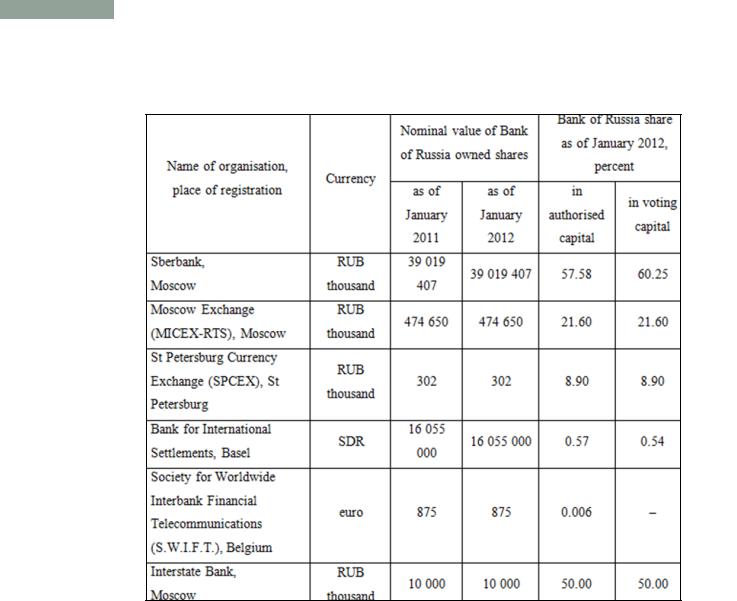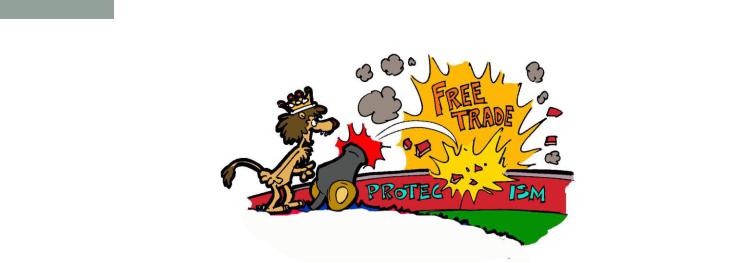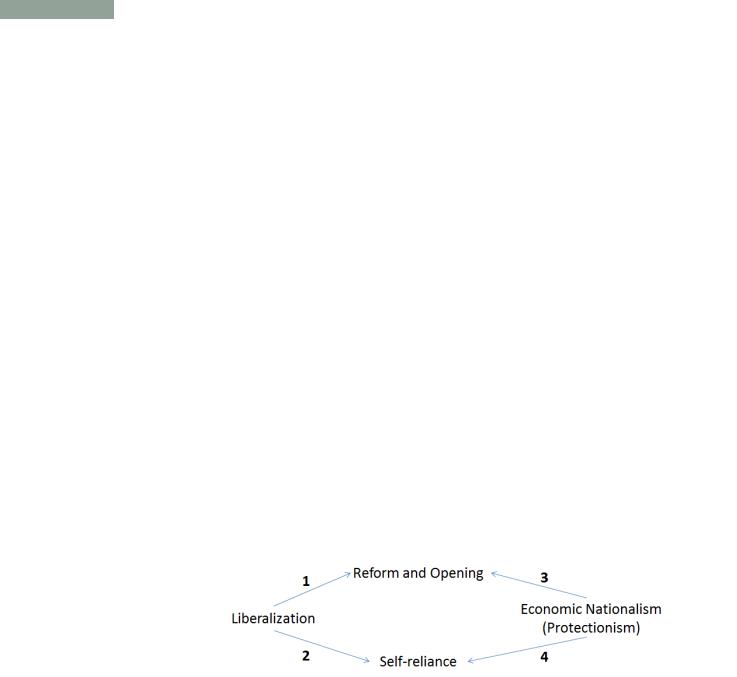
MIR_3_final
.pdf
Журнал международных исследований развития (МИР). №3. 2014
Table 2
CBR Shareholdings (Q1 2012)
Source: CBR (2014)
4. HR POLICY AT THE CENTRAL BANK OF RUSSIA
Human resource management can be defined as ―The policies and practicies in carrying out the ―people‖ or human resources aspects of a management position, including recruitment, screening, training and appraising‖ (Dessler, 2007). In other words, HRM is ―the management activity taken by commercial firms, state owned enterprises and other organisations to recruit, retain and motivate their emplyees‖ (Boxall, Purcell, 2008).
We need to pay attention to factors which support the development of HR. Firms should not only provide employees with education, but also implement factors of motivation.
Nowadays the Bank of Russia tends to continue its activities to improve the management structure. The Central Bank of the Russian Federation comprises HR and Personnel Management Department and International Cooperation Unit which are both responsible for HR strategies and raising staff’s qualifications.
41

Журнал международных исследований развития (МИР). №3. 2014
The recent expansion of several functions led to significant changes in the organisation structure in its headquarter. For instance, the Banking Regulation and Supervision Department was broken down into 2 divisions, which are the Banking Regulation and the Banking Supervision in order to improve the regulation scheme.
As of May 2014, the CBR consists of about 875 divisions, especially the headquarter, 80 regional branches (the 80th was opened in Crimea in 2014), three internal audit divisions, the Security Centre, the Central Depository and its branches.
Recently the CBR HR policy was targeted at improving employees’ performance and the quality of their work against the situation of the centralisation of the Bank’s functions and changing the organisational structure.
As of March 2014, the number of executives and specialists at the CBR grew by 1% comparing to the level of January 2013. Meanwhile, the number of workers under 30 years old declined by
0.5%. More than a half of the Bank’s employees are between 30 and 50 years. The share of workers with 3 to 15 years work experience at the CBR decreased. At the same time the share of employees with more than 15 years work experience significantly increased. Also, in the last few years there was a trend of growing number of specialists and executives with a higher professional education.
Monitoring conduction and a motivation schemes play a dramatic role within the personnel management system. In 2013, 77 CBR’s regional branches and made assessments on a monthly basis. The respective assessment results were taken into consideration in all managerial decisions.
As it follows from the CBR report, the Bank’s staff training priorities are the professional retraining of the Bank of Russia’s divisions’ executives and specialists, the improvement of the competence of division heads and candidates for the Bank of Russia head positions, the development of cooperation within the Bank, motivation and personal efficiency, as well as providing refresher training with respect to monetary, foreign exchange and fiscal policy, the payment system, countering the legalisation (laundering) of criminally obtained incomes and the financing of terrorism, data security and protection, and the application of IFRS. The employees and division heads of the headquarter as well as CBR’s regional branches, undertook specialised training courses in order to gain up-to-date knowledge of certain reporting standards and their application in work.
In 2013 the CBR organised about five thousand training activities within its additional training schemes - more than 43 thousand specialists and executives were involved in those professional events.
Moreover, in 2013 the CBR’s IT staff was trained to enhance and apply modern IT solutions providing electronic documentary support to management.
42

Журнал международных исследований развития (МИР). №3. 2014
The Bank of Russia has banking colleges which traditionally play a great role in the education within this specific sphere, for example The Banking College in the NRU Higher School of Economics. Such institutions hold courses and train employees of the CBR.
Thus, the CBR is likely to solve HR problems which take place almost in each organisation. Empirical evidence shows that the CBR HR policy and strategy seems to be really efficient.
5. DISCUSSION AND CONCLUSION
The modern payment system of Russia consists of two different segments: the payment system of the CBR and private payment systems. The largest part of payments (more than one third in terms of number, and close to 60% in terms of volume) goes through the payment system of the CBR. Regarding interbank payments, the CBR payment system processes close to half of the number of payments, and accounts for almost three quarters in terms of volume. The CBR is the owner and operator of its own payment system designated for servicing crediting institutions (branches) and other clients of the CBR.
The new payments system law adopted in June 2011 grants the CBR supervisory powers over operators of national and international payments systems, including credit institutions that are operators and settlement institutions of private payment systems, in accordance with international standards. The law provides legal definitions for national payment system, electronic money, electronic payment instruments, money transfer operator, e-money operator and other relevant terms. It also sets procedures for operating activities of different types of payment system operators as well as clearing institutions. E-money providers need a license under the law. The new law creates a type of license for non-bank credit institutions, which pursue the activity of transferring money. To obtain a money transfer license, a non-bank credit institution has to comply with a minimum capital requirement of around RUB 18 million.
Increased role of the links between managers and employees proves that human resource management patterns have changed. Implementing an appropriate strategy of a company’s development is an important task which is to be done by employers and empolyees together.
Complexity of structure and operations which we have mentioned above led to some negative effects and CBR’s new approach to HR management. Despite the overall efficiency of the
Central Bank, there are also a lot of arguments against its new role as a megaregulator of the Russian financial system, as its performance does not fit the conditions of New public management (NPM) concept. Such protests have occurred due to corruption, non-publicity and vague executive body’s strategy in the light of recent banking reforms. It is necessary to notice that banking and financial reports of CBR are likely to be unpublished or published with a long time lag.
43

Журнал международных исследований развития (МИР). №3. 2014
Since large organisations have legitimacy problems, they introduced welfare capitalism as a way of creating favorable public opinion. Rational capitalist realized that a better paid work force would be a more loyal, a more efficient one. Business ethics involve two main models (MacKenzie, 2002).
As for the stakeholder model of ethics, it implies that managers have responsibility to all the groups of people with a stake in or an interest in it. These will include suppliers, customers, employees and the local community, as well as the owners and they should be represented in the board of directors. An organisation that is managed for the benefit of all its stakeholders will not pollute the area around its factories or close down a factory employing several hundred people in a small town to make small financial savings. For CBR, the whole population of Russia could be those stakeholders, but the Bank does not implement this pattern. In terms of social responsibility management style, stakeholder model is an essential element on the way towards NPM implementation.
Increased role of the links between managers and employees proves that human resource management patterns have changed. Implementing an appropriate strategy of an organisation’s development is an important task which is to be done by employers and empolyees together. This will make it possible to design a strategy comprising the CBR objectives as well as workers’ interest and motivation.
REFERENCES
Armstrong, M. (2008). Strategic Human Resource Management: A Guide to Action. Kogan Page, London and Philadelphia.
Barnard, G. (2009) Russia’s long and winding road to a more efficient and resilient banking sector, OECD Economics Department Working Paper No. 731, Paris.
Boxall, P., Purcell, J. (2008). Strategy & Human Resource Management, Basingstoke, Palgrave. Central Bank of Russia (2014) Annual Report 2014, Moscow.
Dessler, G. (2007). Human Resource Management. Pearson. Eleventh ed.
Financial Stability Board (2010) Russia: Draft evaluation report on adherence to financial regulatory and supervisory standards concerning international cooperation and information exchange, Basel.
International Monetary Fund (2012) Russian Federation: Technical Note on Stress Testing of the Banking Sector (IMF Country Report No. 11/334), Washington.
MacKenzie, I. (2002). English for Business Studies. Second edition.
Marchington, M., Grugulis, I. (2000). 'Best practice' human resource management: perfect opportunity or dangerous illusion? // The International Journal of Human Resource Management. Volume 11, Issue 6. Pp. 1104-1124.
OECD (2014) Economic Surveys. Russian Federation 2013, Paris.
44

Журнал международных исследований развития (МИР). №3. 2014
Vernikov, A. (2011) Government Banking in Russia: Magnitude and New Features, IWH Discussion Paper No. 13/2011, Halle.
45

Журнал международных исследований развития (МИР). №3. 2014
Idaliya E. Grigoryeva
«You cannot protect something by building a fence around it and thinking that this will help it survive»
Wim Wenders
Balancing Liberalization and Economic Nationalism
in China’s International Trade Policy
ABSTRACT
While liberal and protectionist policies seem to be controversial and incompatible in theory,
China’s example shows quite the opposite in practice. Despite the evident liberalization under the WTO, China still retains certain protectionist measures to promote the state’s national interests. China’s international trade policies are, thus, aimed not at choosing the only one ostensibly right approach, but at striking the balance between liberalism and protectionism. While it might not always be the right balance, China employs significant effort in finding its way. The effectiveness of the course can be assessed by the country’s comparative advantage, specifically, its progress up the comparative advantage stages of trade specialization. On a theoretical level, current China’s policies fall within the bounds of the new interpretation of economic nationalism that makes the emergence of the new ―liberal economic nationalism‖ policy possible.
KEY WORDS
China, International trade, Liberalization
1. INTRODUCTION
The discourse between supporters of liberalization and of protectionist policies is at least two-centuries long. Mercantilists and liberals from the 19th century gave way to neoclassical advocates of Keynesian economics, on the one hand, and IMF preachers of free trade and
46

Журнал международных исследований развития (МИР). №3. 2014
complete liberalization, on the other hand, but the contradiction persists. Rooted in the diverse effects of policies compliant with either of the approaches, the debate continues to draw attention of both academics and policy-makers. The emergence of such a major player on the world market as China fomented further discussion of how those different approaches to trade liberalization vs. protectionism are reconciled in the officially communist state. Here we present how supposedly incompatible policies ensure economic growth and consistent comparative advantage in China, the second-largest economy in the world43.
For the purposes of a valid comparison of policies in this paper, we avoid the debate on defining ―economic nationalism‖ best described in works of Helleiner. Alongside most scholars in international political economy, we continue to refer to economic nationalism in its more established meaning as protectionist policies, e.g. infant-industry protection. In this respect, it does involve non-liberal policies and is, thus, in controversy with liberalism. China’s trade policies will be reviewed under this angle, although the concept of ―liberal economic nationalism‖
44 is not escaping our attention and will be referred to eventually.
2. HISTORICAL BACKGROUND
China faces similar problems in promoting certain protectionist policies as did ―newly industrialized countries (NICs), also referred to as ―Asian tigers‖ including South Korea,
Singapore, Taiwan and Hong Kong. In fact, the experience of NICs countries is one of the first examples of a supposedly quite efficient trade policy combining liberal measures and trade barriers. While the countries were open in terms of export and foreign trade quotas, they retained certain import barriers and infant-industry protection measures. Moreover, in some of the countries the influx of foreign investment was largely regulated, which can be used as an auxiliary trade protection measure, as well.
However, the level of openness and liberalization in those countries was and is relatively higher than in China, and that is where the major difference between NICs states and China lies. The former are small economies, price-takers on the world market that are more dependent on trade to promote national economic growth. First, the local market is not sufficient to utilize economies of scale, hence, larger exports of goods are needed, and second, the countries rely on imports of resource-intensive goods of the heavy industry they are not competitive in. For these reasons, small economies tend to be more liberal while China with its 1.3 billion people in population has much higher internal capacities in both expected internal demand for
43China is regarded as the second-largest economy by real GDP calculated using real exchange rates, not PPP.
44Helleiner, E. Economic nationalism as a challenge to economic liberalism? Lessons from the 19th century.
International Studies Quarterly. No. 46(3). p.319
47

Журнал международных исследований развития (МИР). №3. 2014
manufactured products and available factors of production. Industrialization and urbanization lift more people out of poverty, empower the rising middle class, thus, raising the standard of living and driving internal demand. Furthermore, whereas abundant labor force enables export orientation, policies aimed at reducing regional disparities actually provide grounds for import substitution. Therefore, it can be observed that both liberalization and protectionism might be viable political and economic pursuits.
The problem acquires more facets to it in the context of China’s accession to the WTO in
2001. It is not an easy task to combine ostensibly contradictory policies in the first place, especially, once most of traditional protectionist restrictions become inapproachable due to the signed WTO agreements. Still, China manages to promote certain trade barriers that enable the economy to move up the comparative advantage stages, as identified by Bela Balassa.45
3. IDEOLOGICAL BASE IN CHINA
When exploring China’s foreign trade regulation, two relevant ideological concepts need to be highlighted; they are ―Self-reliance‖ (―zili gengsheng‖) and the ―Reform and opening policy‖ (―gaige kaifang‖). Contradictory at the first glance, these two ideological strands fall within the bounds of trade policy framework representing economic nationalism and trade liberalization, respectively.
The two concepts are not as straightforward and bound to be controversial as they might seem. In terms of international trade, ―self-reliance‖ stresses the importance of only limited dependence on foreign markets and resistance to external economic shocks, but does not promote autarky and ―iron curtain‖, just like economic nationalism ―does not mean economic autarky‖. On the contrary, it continues in the direction of liberal policies in preventing overreliance on international market and foreign actors to promote economic growth of the nationstate. At the same time, reforms and opening up underscore the benefits that can be reaped off of the international markets such as entering new markets to sell exported goods, importing technologies and attracting foreign direct investment (FDI).
4. CHINA’S TRADE REGULATION
First and foremost, it is essential to understand what China’s trade policies are based on and aimed at. China’s export structure is largely defined by the country’s factor endowments, i.e.
45 Balassa, B. A. The Newly Industrializing Countries in the World Economy . New York: Pergamon press.1981. pp.1978-1980
48

Журнал международных исследований развития (МИР). №3. 2014
abundant, and thus cheap, labor force 46 , substantial financial resources derived from an abnormally high marginal propensity to save in China and at the same time still insufficient human capital.
The main driver of trade policies in China is currently concerned with promoting more capitaland knowledge-intensive industries. This ensures that China advances in terms of its
―stage‖ of comparative advantage.47 Since the reforms started in the 1980s, China has been on the ―move to export orientation policy‖ 48 represented in government support of light industries and the large influx of foreign investments to sustain and bolster economic growth. Nevertheless, although export orientation did lead to rising openness and liberalization, it was combined with restrictions aimed at import substitution in a set of industries.
A similar mix of arguably controversial approaches continued to be present in trade policies after China’s accession to WTO in 2001. Foreign commercial policy took a more liberal course while industrial-policy interventions were maintained. In accordance with WTO agreements, the average weighted tariff has been declining with increases in certain industries. Moreover, the Chinese government resorts to non-tariff regulation including quotas, licensing, quality standards, and more country-specific measures, for instance, export rebates, export credit insurance, and soft loans. Under WTO agreements, these have to gradually be abolished, though. On the whole, certain protectionist measures are used as ―a constituent of industrial policy aimed at import substitution in a certain range of products‖ .49
The state of the national economy on the macro level has impact on the trade policy, too. The cyclical fluctuations of the Chinese economy caused by the idiosyncrasies of its growth model force the government to impose trade restrictions during overheating and provide extra stimuli when the economy is on the downward trend to deflation and slower growth.
Since the WTO, more liberalization is observed in terms of better access of international investors to China’s markets and lower tariffs, but so far certain preferential tools are retained, including protection of high-tech industries. The changes are embedded in the laws passed to ensure both liberalization and protectionism. In 2003 China voluntarily joined the WTO Agreement on Information Technologies vowing to eliminate all trade barriers on the corresponding products. In 2006 new ―Science and Technology Development‖ strategy was in place to promote and enforce intellectual property rights in China, expansion on the international
46Recent studies show that excessive labor force in the rural areas is declining with growing urban employment in the secondary and tertiary sectors, but it does not mean yet that China no longer possesses an advantage of cheap labor to bolster minimization of production costs.
47Balassa, B. A. The Newly Industrializing Countries in the World Economy // Pergamon press. 1998
48Gelbras, V. G. Import Substitution and Export Orientation of China’s Economy// Journal of World Economy and International Affairs.1999. No. 7.
49Mozias P., Yakovleva V. China’s Foreign Trade Policy after the Accession to the WTO. Journal of World Economy and International Affairs. 2009. No. 12.
49

Журнал международных исследований развития (МИР). №3. 2014
license market and reduction in use of imported technologies to 30%. In 2006-2007 export rebates were reviewed, henceforth, all benefits for exporters of all raw material, except for metals. This list may be continued, but it is already quite evident that simulative measures go alongside deepening liberalization. Lower tariffs reflect trade liberalization while new incentives to promote export activities of Chinese firms represent 21st century trade protectionism.
5. COMBINING LIBERAL AND PROTECTIONIST
Given all the above, the question arises as to whether such liberal policies and economic nationalism (meaning protectionism) effectively coexist in China. If such a combination is working, is there a general theoretical framework behind it to make the approach applicable in other countries, too?
First, as it was already mentioned, there are economic grounds for China to resort to both export orientation and import substitution policies which include factor endowments, and the path-dependent nature of growth model. Second, the combination of approaches is embedded in the ideology of the Communist Party of China (CPC) in the two concepts of ―self-reliance‖ and the ―reform and opening policy‖. The graph below represents the interaction of the concepts with the two types of economic policy.
Figure 1. Trade policy theory and China’s ideology
Source: Author’s design.
On the graph numbers 1 and 2 represent how liberalization enables the influx of foreign direct investment and larger quantities of exported goods (1), it also increases competition on the national market which helps boost production efficiency contribution to the internal capacities of the economy – self-reliance (2). Numbers 3 and 4 respectively are concerned with export stimulation resulting in growing exports and thus openness (3) and increasing self-reliance through expanding domestically produced range of products (4).
50
